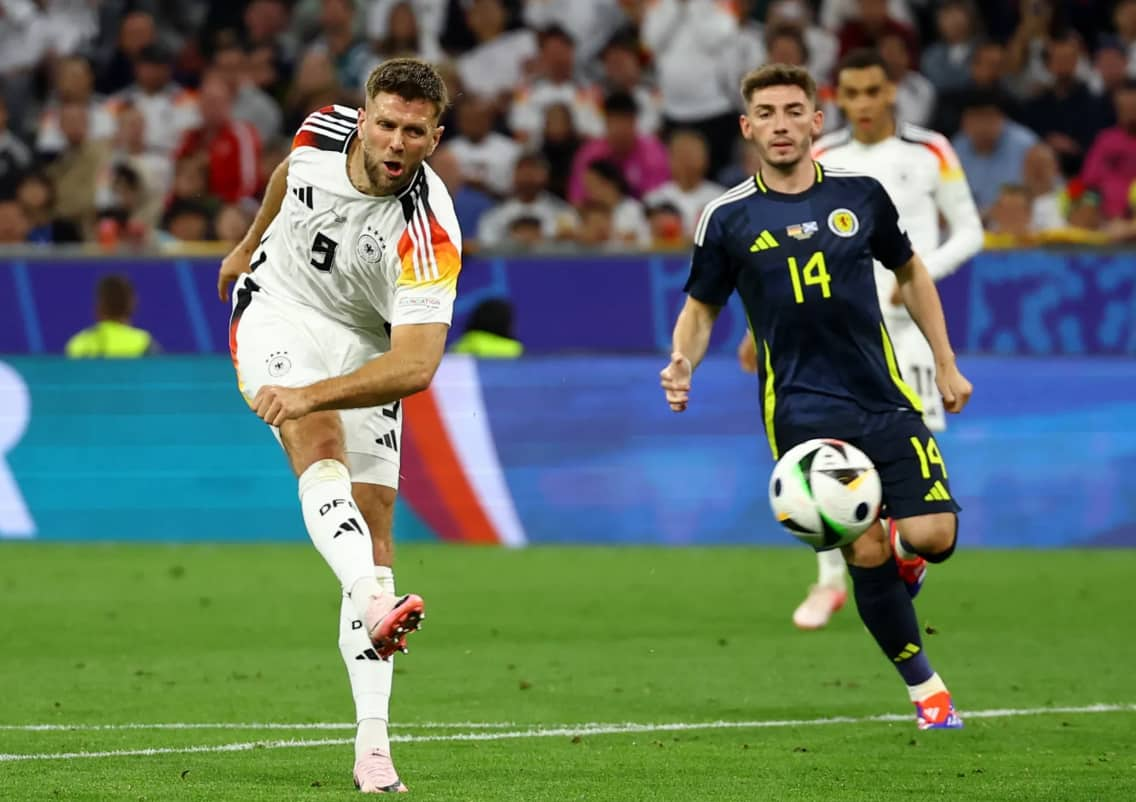Germany national football team vs Scotland national football team lineups took center stage as Euro 2024 launched with a highly anticipated opening fixture.
This match carried special significance beyond just tournament points, serving as Germany’s opportunity to announce their return to elite international football after recent disappointments.
Die Mannschaft faced immense pressure as tournament hosts to perform in front of their home crowd at the magnificent Allianz Arena.
For Scotland, this represented a chance to create an instant tournament legacy by upsetting the hosts in the competition’s curtain-raiser.
Steve Clarke’s men arrived as clear underdogs but with nothing to lose and everything to gain.
The contrast between these nations – Germany with their four World Cup titles and three European Championships versus Scotland still seeking their first knockout stage qualification – highlighted the David versus Goliath narrative.
Yet international tournaments often produce unexpected results, and the opening match atmosphere created a unique environment where tactical preparation, mental resilience, and individual brilliance would determine the outcome.
Germany National Football Team Vs Scotland National Football Team Lineups

Germany’s Strategic Setup
Julian Nagelsmann constructed his Germany lineup with careful consideration of both tactical effectiveness and tournament psychology. The 4-2-3-1 formation provided structural familiarity while maximizing his players’ technical strengths.
| No. | Player | Position | Substituted |
|---|---|---|---|
| 1 | Manuel Neuer | GK | |
| 6 | Joshua Kimmich | RB | |
| 4 | Jonathan Tah | CB | 62′ |
| 2 | Antonio Rüdiger | CB | |
| 18 | Maximilian Mittelstädt | LB | |
| 23 | Robert Andrich | CM | 46′ |
| 8 | Toni Kroos | CM | 81′ |
| 10 | Jamal Musiala | RW | 74′ |
| 21 | İlkay Gündoğan (c) | AM | |
| 17 | Florian Wirtz | LW | 63′ |
| 7 | Kai Havertz | CF | 63′ |
The selection revealed several key strategic decisions:
- Generational balance – Blending veterans (Neuer, Kroos, Gündoğan) with emerging talents (Musiala, Wirtz)
- Positional specialists – Each player operating in their optimal role rather than forced adaptations
- Technical security – Prioritizing possession and ball retention across all positions
- Structural flexibility – Players capable of adapting positions during different game phases
Nagelsmann’s decision to maintain the same starting XI from their final warm-up match signaled confidence and continuity, important psychological factors for a tournament opener. The selection of Havertz as a central striker over Füllkrug indicated a preference for technical link play rather than traditional center-forward play.
Scotland’s Tactical Approach
Steve Clarke arranged his Scotland side in a defensive 3-5-2 formation designed to contain Germany’s technical superiority while maintaining a counter-attacking threat.
| No. | Player | Position | Substituted |
|---|---|---|---|
| 1 | Angus Gunn | GK | |
| 2 | Anthony Ralston | RWB | 48′ |
| 13 | Jack Hendry | CB | |
| 15 | Ryan Porteous | CB | 44′ |
| 6 | Kieran Tierney | CB | 77′ |
| 3 | Andrew Robertson (c) | LWB | |
| 4 | Scott McTominay | CM | |
| 8 | Callum McGregor | CM | 67′ |
| 7 | John McGinn | RW | 67′ |
| 11 | Ryan Christie | LW | 82′ |
| 10 | Ché Adams | CF | 46′ |
Clarke’s lineup reflected several pragmatic considerations:
- Defensive reinforcement – Three center-backs plus wing-backs who could form a back five without possession
- Midfield industry – Work-rate prioritized in central areas to disrupt Germany’s passing rhythm
- Premier League experience – Selecting players accustomed to elite opposition when available
- Transition speed – Adams and Christie offer mobility for counter-attacking opportunities
The forced absence of Lyndon Dykes through injury required tactical adaptation, with Adams taking the central striking role. The selection of Ralston at right wing-back rather than Patterson suggested prioritizing defensive solidity over attacking threat.
Bench Impact and In-Game Management
The quality difference between the nations was perhaps most evident in their substitution options and how they were deployed during the match.
Germany’s Game-Changing Options
| No. | Player | Position | Substituted In |
|---|---|---|---|
| 15 | Nico Schlotterbeck | CB | 62′ |
| 19 | Leroy Sané | RW | 63′ |
| 9 | Niclas Füllkrug | CF | 63′ |
| 13 | Thomas Müller | RW | 74′ |
| 14 | Emre Can | CM | 81′ |
Nagelsmann’s substitutions demonstrated luxurious depth, with each change serving a specific tactical purpose:
- Schlotterbeck for Tah maintained defensive stability while managing playing time
- Sané introduced explosive pace against tiring Scottish defenders
- Füllkrug provided a traditional center-forward presence to dominate aerial duels
- Müller brought tournament experience and game management when replacing Musiala
- Can secure the midfield in the closing stages after Kroos departed
Each German substitute would likely start for most nations at the tournament, highlighting the quality available throughout their squad.
Scotland’s Limited Alternatives
| No. | Player | Position | Substituted In |
|---|---|---|---|
| 5 | Grant Hanley | CB | 46′ |
| 14 | Billy Gilmour | CM | 67′ |
| 23 | Kenny McLean | CM | 67′ |
| 26 | Scott McKenna | CB | 77′ |
| 9 | Lawrence Shankland | CF | 82′ |
Clarke’s substitutions were partly forced through injury and partly aimed at damage limitation:
- Hanley replaced Adams at halftime to shore up the defense rather than maintain an attacking threat
- Gilmour and McLean provided fresh legs in midfield as Scotland’s starters tired
- McKenna replaced the fatigued Tierney to maintain a defensive structure
- Shankland offered a late attacking option with little time to make an impact
The contrast in substitution quality highlighted the resource gap between established footballing powers and smaller nations in international competition.
Player Performance Analysis
Defensive Foundations
Manuel Neuer demonstrated why Nagelsmann maintained faith despite recent injury concerns. His performance featured:
- Commanding presence and organizing the defensive line
- Distribution excellence initiating attacks from deep
- Positional intelligence cutting out potential Scottish breaks
- Vocal leadership throughout the match
Antonio Rüdiger provided the physical and mental intensity that defined Germany’s defensive approach. His contributions included:
- Dominant aerial presence winning virtually all contested headers
- Recovery pace to cover spaces behind the advanced fullbacks
- Aggressive challenge forcing Scottish attackers to rush decisions
- Building attacks with progressive passing from the defense
For Scotland, Kieran Tierney epitomized their defensive determination despite the quality gap. His performance showed:
- Tactical discipline maintaining a defensive shape
- Physical commitment in every challenge
- Communication organizing those around him
- Versatility covering multiple defensive zones
Midfield Control
Toni Kroos defined Germany’s midfield dominance through his technical excellence and tactical intelligence. His game featured:
- Metronomic passing maintains possession under pressure
- Positional discipline provides constant passing options
- Defensive anticipation intercepting Scottish transitions
- Leadership guiding younger teammates through the match
For Scotland, Scott McTominay shouldered immense defensive responsibility while attempting to provide offensive support. His performance included:
- Relentless work-rate covering defensive ground
- Physical presence disrupting German buildup play
- Aerial threat during set-piece situations
- Forward runs when rare attacking opportunities arose
Robert Andrich provided the midfield balance that allowed Germany’s creative players to flourish. His contributions featured:
- Disciplined positioning screening the defense
- Aggressive pressing to regain possession quickly
- Simple but effective passing maintaining possession
- Tactical fouls when necessary to prevent counter-attacks
Creative Influences
Jamal Musiala terrorized Scotland’s defense with his exceptional technical ability and movement. His performance showcased:
- Electric dribbling in tight spaces eliminating defenders
- Intelligent movement finding spaces between defensive lines
- Creative vision spotting passes others couldn’t see
- Defensive work-rate supporting team structure without the ball
Florian Wirtz complemented Musiala perfectly with his brand of technical excellence. His game featured:
- Close control maintaining possession under pressure
- Acceleration exploiting space behind advancing defenders
- Combination play linking effectively with teammates
- Positional flexibility moving between left-wing and central areas
For Scotland, John McGinn attempted to provide a creative spark despite limited possession. His performance included:
- Technical security retaining possession when under pressure
- Set-piece delivery provides rare attacking opportunities
- Defensive discipline supporting the midfield structure
- Leadership encouraging teammates throughout the challenge
Tactical Battlegrounds
Build-Up Play vs Pressing Approach
Germany’s build-up strategy centered around creating numerical superiority in deep areas. Neuer effectively operated as an additional outfield player, while Kroos constantly dropped to receive possession. This patient approach systematically dismantled Scotland’s pressing attempts, which became increasingly disjointed as the match progressed.
Scotland initially attempted to press through Adams and Christie, supported by midfield runners. However, Germany’s technical security meant this approach quickly became unsustainable, forcing Scotland to adopt an increasingly deep defensive block that surrendered territorial advantage.
Width Exploitation vs Defensive Narrowing
Germany’s attacking width came through contrasting approaches on each flank. Kimmich provided traditional overlapping runs on the right, while Mittelstädt’s more conservative positioning on the left allowed Wirtz freedom to drift inside. This asymmetrical approach created confusion in Scotland’s defensive assignments.
Scotland attempted to counter this by narrowing their defensive block when the ball moved wide, but this created central spaces that Gündoğan and Musiala exploited effectively. The balance between protecting wide areas while maintaining central compactness proved an unsolvable puzzle for Clarke’s men.
Transition Moments
Germany’s counter-pressing excellence neutralized Scotland’s primary attacking strategy. Within seconds of losing possession, coordinated pressing from Germany’s front players regained the ball before Scotland could transition from defense to attack. This effectively eliminated Scotland’s hope of threatening through counter-attacks.
On the rare occasions Scotland did break the initial press, Germany’s defensive recovery speed prevented dangerous situations from developing. Rüdiger and Tah showed excellent anticipation to intercept attempted passes toward Adams, while Kimmich and Mittelstädt recovered position quickly when caught forward.
Strategic Insights
Germany’s Evolution Under Nagelsmann
This performance demonstrated significant evolution in Germany’s approach compared to recent tournaments:
- Positional fluidity – Attack-minded players are given the freedom to interchange positions
- Press-resistance – Every player is comfortable retaining possession under pressure
- Counter-pressing – Immediate, coordinated pressure when possession is lost
- Patience – Willingness to circulate possession rather than force play
Nagelsmann has successfully blended traditional German tactical discipline with modern positional play concepts. The incorporation of technically gifted younger players like Musiala and Wirtz alongside experienced campaigners has created a balanced squad capable of adapting to different opponents and match situations.
Scotland’s Tournament Reality
For Scotland, this match highlighted both challenges and potential positives:
- Technical gap – Significant difference in individual technique under pressure
- Defensive organization – Periods of effective structural defensive play
- Physical commitment – Wholehearted effort despite quality disadvantage
- Tournament learning – Valuable experience against elite opposition
Clarke’s challenge will be to maintain the squad’s confidence while adapting their approach for more winnable group matches. The defensive organization shown in patches provides a foundation to build upon, while greater attacking ambition will be possible against teams closer to Scotland’s level.
FAQs
- Why did Julian Nagelsmann select Kai Havertz as a central striker rather than a traditional center-forward?
Nagelsmann selected Havertz for his technical ability and movement rather than traditional center-forward characteristics. This choice prioritized link-up play and positional fluidity, allowing Germany’s attack to be less predictable. Havertz’s ability to drop deep created space for Musiala and Wirtz to attack from wide positions, while his intelligent movement pulled Scotland’s defenders out of position.
- How did Scotland attempt to contain Jamal Musiala and Florian Wirtz?
Scotland used a combination of tight marking and defensive depth to limit spaces for Germany’s creative talents. When possible, they attempted to double-team Musiala and Wirtz in wide areas. However, the positional fluidity of Germany’s attack made consistent marking assignments difficult to maintain, with both players finding dangerous spaces between Scotland’s defensive lines.
- What was Toni Kroos’ specific role in Germany’s midfield?
Kroos operated as the deep-lying playmaker responsible for dictating Germany’s tempo and distribution. He consistently positioned himself to receive possession from defenders, creating the first line of progression in Germany’s build-up play. Defensively, he provided positional intelligence rather than aggressive pressing, intercepting passes, and blocking passing lanes through perfect positioning.
- How significant was the absence of Lyndon Dykes for Scotland’s tactical approach?
Dykes’ absence significantly impacted Scotland’s attacking strategy. As a physical target forward, he would have provided a focal point for direct passes and an aerial threat against Germany’s defense. Without him, Scotland lacked the option to bypass midfield pressure through direct play, forcing them into technical areas where Germany held a clear advantage.
- What tactical adjustments could Scotland have made to improve their performance?
Scotland might have benefited from a more compact mid-block rather than attempting to press high initially. Conserving energy by allowing Germany possession in non-threatening areas could have preserved stamina for more sustained counter-attacking threat. Additionally, more direct play toward Adams in transition moments might have exploited spaces behind Germany’s advanced fullbacks.
- What does this opening performance suggest about Germany’s tournament prospects?
Germany’s performance indicated they are serious contenders for the championship. The balance between defensive solidity and attacking creativity suggests Nagelsmann has successfully addressed weaknesses from recent tournaments. Perhaps most importantly, the confident display should generate positive momentum and belief within the squad, crucial factors for tournament success.
Also Check:
- Georgia Bulldogs Football vs Texas Longhorns Football Match Player Stats
- Brazil National Football Team vs Argentina National Football Team Lineups
- Chivas de Guadalajara vs Club America Lineups
- Poland National Football Team Vs Portugal National Football Team Lineups
Conclusion:
The germany national football team vs scotland national football team lineups reflected not just personnel choices but broader footballing philosophies shaped by different resources and expectations. Germany’s selection demonstrated technical excellence and tactical sophistication, blending established stars with exciting young talents to create a formidable unit. The balance between experience and youth, defense and attack, structure and creativity suggests Nagelsmann has found a formula that could carry Germany deep into the tournament.
Scotland’s lineup revealed Steve Clarke’s pragmatic assessment of the challenge they faced. With limited resources compared to their illustrious opponents, Scotland prioritized defensive organization and physical commitment, hoping to frustrate Germany while seizing any counter-attacking opportunities. The early injury setbacks compounded their challenge, but the fighting spirit shown throughout embodied the determination that had carried them to qualification.
The quality gap between the squads was evident throughout the match. Germany’s ability to maintain possession under pressure, create chances through intricate passing combinations, and introduce game-changing substitutes contrasted with Scotland’s more limited options. Yet international tournaments often produce unexpected results, and Scotland’s experience against the hosts will prove valuable for their remaining group matches.
For Germany, this opening performance provided encouraging signs for their tournament ambitions. The fluidity of their attacking play, midfield control, and defensive organization suggested they have developed significantly under Nagelsmann’s guidance. If they can maintain this level throughout the tournament, they will be strong contenders to lift the trophy on home soil.
Scotland will take important lessons from this challenging opener as they focus on their remaining group matches. The experience gained against one of the tournament favorites should serve them well when facing opponents closer to their own level. Clarke will hope that the defensive organization shown in patches against Germany can be maintained while finding more attacking opportunities in future games.
As Euro 2024 unfolds, both teams will continue evolving their approaches based on lessons learned from this opening encounter. Germany has set a high standard with their performance, while Scotland has gained valuable tournament experience that will serve them well in their quest to create history by reaching the knockout stages for the first time.


